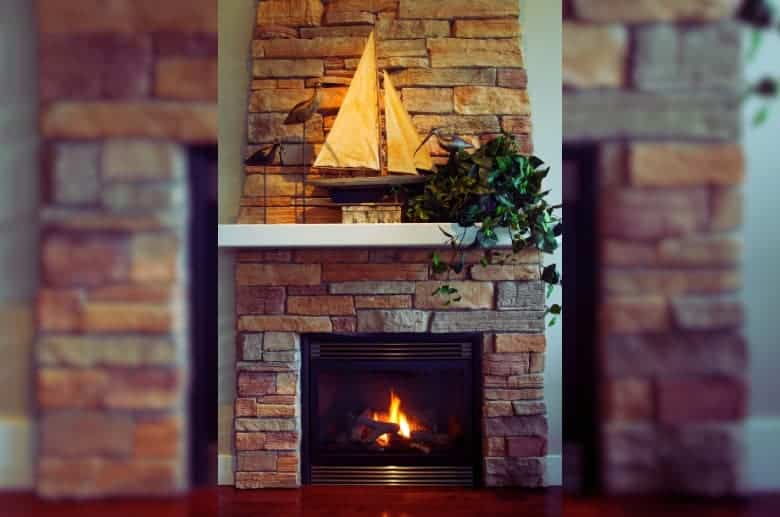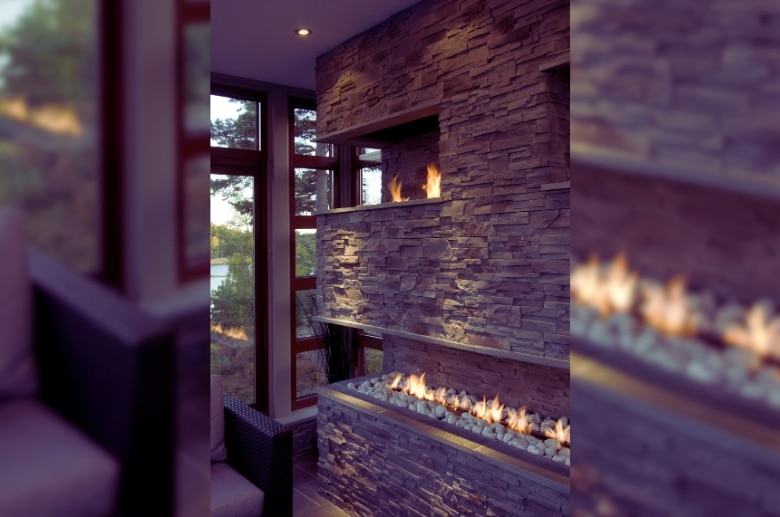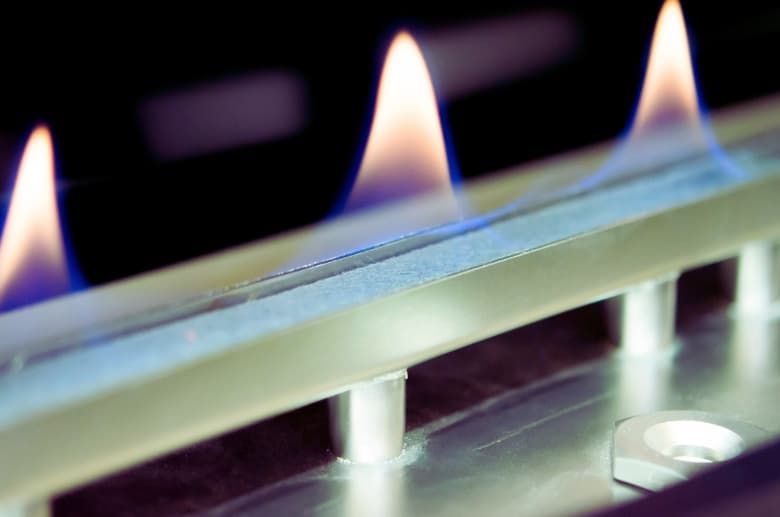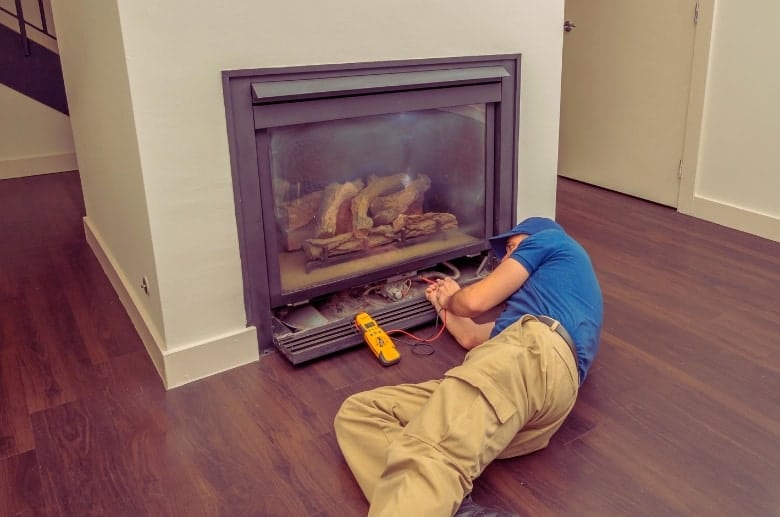In your journey for finding the perfect gas fireplace, you’ve likely encountered the two predominant types on the market: vented and ventless.
The choice between them isn’t just about picking a heating appliance, it’s about understanding the nuances that define your home’s warmth and ambiance.
A vented gas fireplace requires a chimney or flue system to expel the combustion byproducts outside, ensuring that the romance of a flickering flame doesn’t compromise indoor air quality. Ventless or vent-free gas fireplaces, on the other hand, don’t require a chimney or external venting flue system. Instead, it burns gas fuel and releases the combustion byproducts directly into the room.
Although they may appear similar on the outside, these fireplaces have distinct differences in efficiency, aesthetics, and overall functionality. Understanding these disparities will help you select the best option, especially if you are new to gas fireplaces.
Join us as we dissect the pros and cons of vented vs ventless gas fireplaces. Through this comprehensive comparison, we’ll illuminate the path to understanding, empowering you with the insights needed to choose the fireplace that not only meets but exceeds your expectations.
Difference Between Vented And Ventless Gas Fireplaces
In this section, we will analyze each type individually, exploring their respective working principles and advantages and disadvantages.

Vented Gas Fireplaces
Vented gas or traditional fireplaces require a chimney or flue system for ventilation. These fireplaces draw in air from the outside to support combustion and release the combustion byproducts outside.
Vented gas fireplaces utilize a sealed combustion system, where the air for combustion is separate from the room air, ensuring safety and optimal indoor air quality. The following are some advantages and disadvantages of using a vented gas fireplace.
Advantages of Vented Gas Fireplaces
- Aesthetics: Vented gas fireplaces provide a realistic and visually appealing flame, mimicking the ambience of a traditional wood-burning fireplace. Also, the dancing flames and glowing embers create a warm, cozy atmosphere like a wood-burning stove.
- Safety: According to the CDC, over 500 people in the USA die from home heating hazards annually. Vented fireplaces ensure the safe expulsion of combustion byproducts, such as carbon monoxide, soot, and moisture, through the chimney or flue system. This helps maintain good indoor air quality and minimizes potential health hazards.
- Flexibility: Since vented gas fireplaces have a chimney to remove by-products like carbon monoxide and soot, they can be fueled by natural gas or propane. This flexibility in fuel options allows you to select the fuel source that best suits your needs and availability.
- Design Customization: Vented gas fireplaces offer various design choices, including sizes, styles, and materials. You can select from different types of logs, decorative inserts, mantels, and surrounds to match your interior decor and personal preferences.
——
Do You Need to Hire Chimney & Fireplace Expert?
Get free quotes from qualified experts near you. No commitment required!
——
Disadvantages of Vented Gas Fireplaces
- Installation: Installing a vented gas fireplace can be more complex and expensive than ventless options. The process requires constructing a chimney or using an existing one, which may involve significant structural modifications and professional assistance.
- Heat Loss: A portion of the heat generated from vented fireplaces escapes through the chimney or flue. This results in heat loss and reduced energy efficiency in homes, making them less efficient for primary heating.
When comparing fireplace and furnace efficiency, it’s important to consider this aspect, as furnaces typically do not suffer from the same level of heat loss due to their closed combustion systems. - Interference with Interior Design: Vented gas fireplaces require a connection to an exterior wall or roof for proper venting. This limits their placement options within your home, impacting your overall layout and design possibilities.
- Regular Maintenance: Cleaning, inspecting the chimney for blockages or damage, and addressing arising issues are time-consuming and costly since it involves hiring a professional.

Ventless Gas Fireplaces
Ventless gas fireplaces, known as vent-free or unvented fireplaces, do not require a chimney or flue for ventilation. They burn gas fuel, such as natural gas, and release the heat into the room.
Additionally, ventless fireplaces use a specialized burner and an oxygen depletion sensor to ensure safe indoor operation and monitor air quality.
Advantages of Ventless Gas Fireplaces
- Easy Installation: The installation process of ventless gas fireplaces is relatively easy since they do not require venting infrastructure like a chimney or flue pipe. This makes them suitable for various settings, including apartments, condos, or rooms without access to a chimney.
- High Efficiency: Ventless fireplaces are designed to maximize heat production, as all the gas heated is converted into heat and released directly into the room. This feature makes them highly efficient and can serve as a primary heating source, especially in well-insulated spaces.
- Flexibility: The absence of a chimney or flue gives you greater flexibility and options in placing a ventless gas fireplace within any room.
- Cost-Effective: Ventless gas fireplaces generally have lower installation costs than vented options, as there is no need for chimney construction or modification.
- Oxygen Depletion Sensors: Ventless fireplaces are equipped with oxygen depletion sensors that shut off the gas supply if oxygen levels in the room fall below a certain point. This safety feature prevents harmful gases from building up in the room.
Disadvantages of Ventless Gas Fireplaces
- Safety: Since ventless fireplaces release combustion byproducts directly into the room, there can be concerns about indoor air quality. However, ventless fireplaces have oxygen depletion sensors that shut off the gas supply if oxygen levels in the room fall below a certain point. Nevertheless, we highly recommend ensuring proper room ventilation whenever the fireplace operates.
- Moisture Buildup: The combustion process in ventless fireplaces produces moisture, increasing room humidity. If not properly managed, this may cause condensation, mold growth, or discomfort.
- Limited Aesthetics: Ventless fireplaces prioritize heat production over flame aesthetics. They burn with a bluish flame, limiting the level of realism and authenticity of a wood stove.
- Sensitivity to Room Size: The room size typically regulates the heat output of ventless fireplaces. If your fireplace is too small for a large space, it may struggle to provide sufficient heat to warm your home adequately. On the other hand, if your fireplace is too large for a small space, it may generate excessive heat, making your home uncomfortable.
Comparison of Vented vs Ventless Gas Fireplaces
To help you understand how vented gas fireplaces compare to ventless gas fireplaces, we have compiled an in-depth guide that puts these two options on a scale by examining various aspects. Below are key factors we’ll explore to help you make an informed decision.
1. Durability
Both fireplaces are built to withstand regular use and provide long-lasting performance. However, vented gas fireplaces are typically constructed with sturdy materials like cast iron or steel.
These materials are known for their durability and can last up to 20- 25 years with proper maintenance. Its venting system, including the chimney and flue, is also designed to withstand high temperatures and harsh weather conditions.
On the other hand, ventless gas fireplaces are built of ceramic logs or fiber-reinforced refractories. These are durable heat-resistant materials, but their durability can not be compared to that of a vented gas fireplace. Nevertheless, a ventless gas fireplace can last up to 15-20 years with proper care and maintenance.
2. Burners

Vented gas fireplace burners are typically designed to produce a more realistic and visually appealing flame. They often feature multiple burner ports and tiers, allowing for a natural-looking flame pattern.
In contrast, ventless gas fireplaces utilize burners specifically designed for efficient heat production rather than flame aesthetics. The burners in ventless models are engineered to optimize the combustion process, ensuring complete fuel burn and maximum heat output.
3. Installation Cost
A vented gas fireplace will cost you more to install compared to a ventless system. On average, you will be expected to spend around $3,500 to $7,500. This is because you will require a chimney or a wall vent for ventilation for the efficient functioning of your fireplace.
If your home lacks one, you will incur construction work, materials, and labor costs, which can be costly.
On the other hand, ventless gas fireplaces do not require a chimney or flue system, which results in lower installation costs, around $2,000 to $3,300. Without additional construction work, ventless fireplaces can be more affordable to install.
4. Running Cost
Vented gas fireplaces that use liquid propane or natural gas tend to have higher running costs than ventless models. One of the reasons for this is that vented fireplaces do not burn fuel as efficiently as ventless fireplaces. The combustion process in vented fireplaces often wastes some fuel as it is expelled through the chimney or flue.
As a result, vented gas fireplaces can consume around $0.50 worth of liquid propane per hour of operation. The wasted fuel contributes to the higher running cost of vented fireplaces.
In contrast, ventless gas fireplaces are designed to maximize fuel efficiency and minimize waste. Due to this, ventless gas fireplaces have lower running costs of around $0.25 worth of fuel per hour, bringing the total to $180 monthly (If running 24/7).
These fireplaces burn fuel more completely since there is no need for a chimney or flue system to expel byproducts.
5. Efficiency and Heat Output
When choosing an efficient gas fireplace, it’s crucial to weigh the benefits of ventless models against traditional vented options.
Ventless gas fireplaces are designed to maximize heat output and efficiency by up to 99%. This means that a significant portion of the fuel burned is converted into usable heat, resulting in effective and efficient heating for your space.
The heat output of ventless gas fireplaces is also generally higher than vented models. Modern ventless gas fireplaces can give outputs of 20,000 to 40,000 BTUs, making them a more efficient choice in terms of heating performance.
On the contrary, vented fireplaces have lower efficiency ratings of up to 70 to 85%. Some of the heat from the fuel is partially lost through the ventilation system, reducing the overall heat delivered into the room. This lowers their heat output, with most models delivering around 8,000 to 14,000 BTUs.
6. Safety and Air Quality
Vented gas fireplaces are designed with a venting system, like the chimney or flue, which expels combustion byproducts like carbon monoxide (CO) outside your home. This venting mechanism ensures proper ventilation, reducing the risk of harmful gasses accumulating indoors.
Inversely, ventless gas fireplaces do not have a venting system. Instead, they are designed to burn fuel more completely, minimizing the production of harmful gasses such as carbon monoxide in your home.
Their fireplaces also incorporate oxygen depletion sensors that monitor the oxygen levels in your home and automatically shut off the fireplace if oxygen levels become too low.
Nonetheless, it’s crucial to note that ventless gas fireplaces still emit small combustion byproducts, including water vapor and trace amounts of nitrogen dioxide (NO2). Such elements may be a health hazard if you have a record of respiratory conditions or allergies.
7. Maintenance

Vented gas fireplaces require more maintenance due to the presence of a chimney or flue system. The chimney or flue requires regular inspection to ensure it is free of debris or obstructions that could hinder proper ventilation.
Additionally, the chimney may require periodic cleaning to remove soot, creosote, or other deposits that can accumulate over time.
On the other hand, ventless gas fireplaces have relatively lower maintenance requirements. Since they do not have a chimney or flue system, there is no need for regular inspections or cleanings related to ventilation.
However, routine cleaning of the fireplace components, such as the burner, logs, and glass doors, is still necessary to maintain their appearance and functionality.
——
Do You Need to Hire Chimney & Fireplace Expert?
Get free quotes from qualified experts near you. No commitment required!
——
8. Environmental Impact
The combustion process in vented fireplaces releases byproducts such as carbon dioxide, nitrogen dioxide, and particulate matter into the atmosphere through the chimney. These emissions contribute to air pollution and negatively impact local air quality.
Conversely, ventless gas fireplaces are designed to burn fuel more completely, reducing emissions. Lacking a venting system also eliminates the direct release of combustion byproducts into the outdoor environment.
Regardless, it’s crucial to note that ventless fireplaces still produce some emissions within the indoor space, primarily in water vapor and trace amounts of nitrogen dioxide.
| Factors | Vented Gas Fireplace | Ventless Gas Fireplace |
| Lifespan | Between 20-25 years | Between 15-20 years |
| Burners | Designed for a more realistic and visually appealing flame | Designed for efficient heat production |
| Installation Cost | $3,500 to $7,500. | $2,000 to $3,300 |
| Running Cost | $0.50 per hour | $0.25 per hour |
| Efficiency and Heat Output | Lower efficiency and heat output of between 70-85% | Higher efficiency and heat output of up to 99% |
| Safety and Air Quality | Safe with optimum care and maintenance | Generally safe with optimum care and maintenance |
| Maintenance | Higher maintenance costs | Slightly lower maintenance costs |
| Environmental Impact | Less eco-friendly | Slightly more eco-friendly |
Which is Better Vented or Ventless Gas Fireplace
You should consider several factors when deciding between vented and ventless gas fireplaces. These factors include:
1. Personal Preferences and Lifestyle Considerations
If you prioritize the aesthetic appeal of a realistic flame and are willing to accept lower heat efficiency, a vented gas fireplace may be the preferred choice.
However, if you prefer heat output and efficiency over the appearance of a flame, a ventless gas fireplace could be more suitable.
2. Existing Infrastructure
If your home already has a chimney or flue system, opting for a vented gas fireplace can be more convenient and cost-effective. On the other hand, if you don’t have existing ventilation infrastructure, a ventless gas fireplace will suffice.
3. Clearance Requirements
Regarding clearance requirements, ventless gas fireplaces undergo rigorous testing to meet safety standards. Some areas may not approve the installation of ventless fireplaces due to concerns related to air quality and potential health risks.
Before considering the type of gas fireplace, it’s essential to consult with local building officials or professionals experienced in gas fireplace installations. They can provide specific information regarding clearance requirements, building codes, and any restrictions or limitations in your area.
4. Space and Room Size
Ventless gas fireplaces may struggle to heat large spaces adequately. This is unlike vented gas fireplaces, which are generally more efficient in terms of heat output for their size.
Consider your room’s square footage and select a fireplace that matches your heating requirements.
5. Safety and Health Considerations
Vented gas fireplaces offer the advantage of expelling combustion byproducts to the outdoors through the chimney or a wall vent. This minimizes indoor air pollution and potential health risks.
On the other hand, ventless gas fireplaces are also equipped with oxygen depletion sensors and have lower emissions within the room. However, they are considered less safe for people with respiratory conditions and allergies.
——
Do You Need to Hire Chimney & Fireplace Expert?
Get free quotes from qualified experts near you. No commitment required!
——
6. Budget
The amount you are willing to spend is crucial in selecting the type of fireplace. Vented gas fireplaces typically require more installation work, including the cost of a chimney or flue system, which can increase upfront expenses.
Ventless gas fireplaces are often more cost-effective in terms of installation since they don’t require additional venting. However, you should also consider long-term operational costs, like fuel and maintenance expenses.
What Are Some Recommendations for Different Situations?
When deciding between a vented and ventless gas fireplace, it’s important to consider various factors and choose the option that best suits your situation. Here are some recommendations based on different scenarios:

- Ambience: A vented gas fireplace would be a suitable choice if your primary goal is to create a cozy and visually appealing atmosphere with a realistic flame. The open flame and real logs enhance the ambience and provide a traditional fireplace experience.
- Heating Efficiency: Ventless fireplaces are designed to provide higher heat output and can efficiently warm the room without losing heat through a chimney or flue. This feature qualifies it as an ideal option to heat your home efficiently.
- Flexibility: A ventless gas fireplace is viable if you want a heating option that will not alter your home’s interior design. Ventless fireplaces do not require venting, allowing greater freedom in positioning and placement within a room.
The Winner
Vented gas fireplaces offer a traditional and realistic flame appearance but may have lower heat efficiency and require a chimney or flue for proper ventilation.
On the other hand, ventless fireplaces provide higher heat output and efficiency and don’t require venting, but they may have stricter clearance requirements and can impact indoor air quality.
Nevertheless, a ventless gas fireplace may be worth considering if you want a flexible, pocket-friendly option. But a vented gas fireplace might be the best choice if you want a safer, more regulated heating option.
Contact a professional fireplace installer to discuss your options, get personalized advice, and receive quotes for vented and ventless gas fireplaces.
FAQs
Here are two of the most frequently asked questions about vented and ventless fireplaces:
Can a vented gas fireplace be converted to a ventless one, or vice versa?
It’s not recommended to convert a vented gas fireplace to a ventless one. The conversion between the two fireplaces involves significant changes to the design, components, and ventilation systems, which can compromise the safety and efficiency of the fireplace.
Additionally, the conversion can be costly since more materials and time will be needed for the modifications.
Can you use ventless gas logs in a vented fireplace?
You can comfortably use a ventless gas log in a vented fireplace. However, you must take certain precautions and ensure proper safety measures.
While the chimney in a vented fireplace will help eliminate the combustion byproducts, it’s essential to prioritize safety by incorporating carbon monoxide and oxygen detectors to help you ensure the air you breathe is safe.






